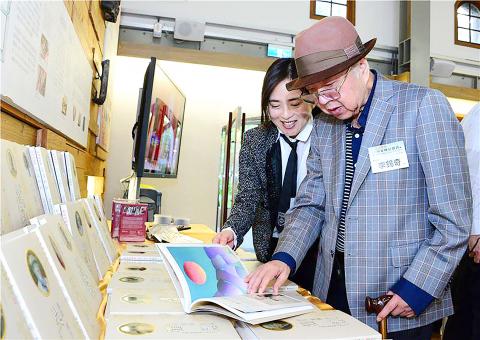A former national policy adviser to the president, who was also the winner of Taiwan’s prestigious National Award for Arts, died on Friday, his family said.
Artist Lee Shi-chi (李錫奇), 81, died in hospital after suffering a brain hemorrhage on Tuesday, his family said.
Born in Kinmen in 1938, Lee was known for a variety of art forms, including prints, ink drawings, abstract calligraphy, lacquer paintings, mixed media works and installations, said Liang Gallery, which has a collection of Lee’s pieces.

Photo courtesy of the Ministry of Culture
Due to his various artistic styles and his incorporation of Oriental traditions with modern Western philosophies, Lee earned the nickname “Bird of Artistic Variations,” Liang Gallery said in its introduction to the artist on its Web site.
Lee’s early creations featured prints on parachutes, a material he found when serving in the military in the 1960s.
Because of the parachutes’ rough texture, Lee’s works possess an explosive visual effect, the National Culture and Arts Foundation said.
In the 1970s, Lee was inspired by Chinese calligraphy and hyperrealism in the US, and began painting with airbrushes, the foundation said, adding that the tool helped Lee create a series of large paintings titled Big Calligraphy.
Lee switched to lacquer painting after a trip to China in the 1990s, and focused on the wrinkling effect that traditional lacquer painters tended to avoid, it said.
In 2012, Lee was honored with Taiwan’s 16th National Award for Arts for “experimenting on new artistic materials,” the “rich Oriental traditions of his works,” and the “promotion of Taiwan’s arts exchanges with international arts,” the foundation said.
In 2015, Lee was appointed by then-president Ma Ying-jeou (馬英九) as one of his national policy advisers, the Presidential Office said.
“I was shocked by the news of Lee’s death tonight,” writer Chen Fang-ming (陳芳明) wrote on Facebook on Friday. “I loved Lee’s style because it was always candid and straightforward, and there were no limitations in his work.”

Taiwan is to commence mass production of the Tien Kung (天弓, “Sky Bow”) III, IV and V missiles by the second quarter of this year if the legislature approves the government’s NT$1.25 trillion (US$39.78 billion) special defense budget, an official said yesterday. Commenting on condition of anonymity, a defense official with knowledge of the matter said that the advanced systems are expected to provide crucial capabilities against ballistic and cruise missiles for the proposed “T-Dome,” an advanced, multi-layered air defense network. The Tien Kung III is an air defense missile with a maximum interception altitude of 35km. The Tien Kung IV and V

The disruption of 941 flights in and out of Taiwan due to China’s large-scale military exercises was no accident, but rather the result of a “quasi-blockade” used to simulate creating the air and sea routes needed for an amphibious landing, a military expert said. The disruptions occurred on Tuesday and lasted about 10 hours as China conducted live-fire drills in the Taiwan Strait. The Civil Aviation Administration (CAA) said the exercises affected 857 international flights and 84 domestic flights, affecting more than 100,000 travelers. Su Tzu-yun (蘇紫雲), a research fellow at the government-sponsored Institute for National Defense and Security Research, said the air

Taiwan lacks effective and cost-efficient armaments to intercept rockets, making the planned “T-Dome” interception system necessary, two experts said on Tuesday. The concerns were raised after China’s military fired two waves of rockets during live-fire drills around Taiwan on Tuesday, part of two-day exercises code-named “Justice Mission 2025.” The first wave involved 17 rockets launched at 9am from Pingtan in China’s Fujian Province, according to Lieutenant General Hsieh Jih-sheng (謝日升) of the Office of the Deputy Chief of the General Staff for Intelligence at the Ministry of National Defense. Those rockets landed 70 nautical miles (129.6km) northeast of Keelung without flying over Taiwan,

A strong continental cold air mass is to bring pollutants to Taiwan from tomorrow, the Ministry of Environment said today, as it issued an “orange” air quality alert for most of the country. All of Taiwan except for Hualien and Taitung counties is to be under an “orange” air quality alert tomorrow, indicating air quality that is unhealthy for sensitive groups. In China, areas from Shandong to Shanghai have been enveloped in haze since Saturday, the ministry said in a news release. Yesterday, hourly concentrations of PM2.5 in these areas ranged from 65 to 160 micrograms per cubic meter (mg/m³), and pollutants were